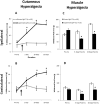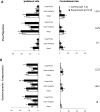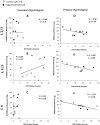Acidic saline-induced primary and secondary mechanical hyperalgesia in mice
- PMID: 19592308
- PMCID: PMC2787877
- DOI: 10.1016/j.jpain.2009.04.014
Acidic saline-induced primary and secondary mechanical hyperalgesia in mice
Abstract
Most of our knowledge about chronic musculoskeletal pain is based on cutaneous pain models. To test the hypothesis that animals develop chronic muscular hyperalgesia following intramuscular acidic saline injections, primary hyperalgesia within the gastrocnemius muscle was analyzed compared to secondary cutaneous hyperalgesia in the hind paw that develops following intramuscular acid saline injection. Two acidic saline (pH 4) injections were administrated into the gastrocnemius of female CF-1 mice. The results indicate that mice developed a robust hypersensitivity bilaterally in primary (gastrocnemius muscle) secondary (cutaneous hind paw) sites that lasted up to 2 weeks. In addition, primary hyperalgesia correlated well with levels of Fos expression. Fos expression patterns in the spinal cord were different for primary secondary site stimulation. Hind-paw palpation stimulated ipsilateral Fos expression in the superficial spinal laminae at L4/L5 levels, bilaterally in deep laminae at L2-L5 spinal levels. In contrast, gastrocnemius compression stimulated widespread Fos expression in all regions of the ipsilateral dorsal horn within L2-L6 spinal segments. These findings indicate that acidic saline injection induces primary hyperalgesia in muscle that the patterns of Fos expression in response to primary vs secondary stimulation are strikingly different.
Perspective: This study assesses primary site muscular pain, which is the main complaint of people with musculoskeletal conditions, and identifies spinal patterns activated by noxious mechanical stimuli to the gastrocnemius. This study demonstrates approaches to test nociception arising from muscle aids in our understanding of spinal processing of primary secondary site hyperalgesia.
Figures





Similar articles
-
Unilateral intramuscular injections of acidic saline produce a bilateral, long-lasting hyperalgesia.Muscle Nerve. 2001 Jan;24(1):37-46. doi: 10.1002/1097-4598(200101)24:1<37::aid-mus4>3.0.co;2-8. Muscle Nerve. 2001. PMID: 11150964
-
Activation of NMDA receptors in the brainstem, rostral ventromedial medulla, and nucleus reticularis gigantocellularis mediates mechanical hyperalgesia produced by repeated intramuscular injections of acidic saline in rats.J Pain. 2010 Apr;11(4):378-87. doi: 10.1016/j.jpain.2009.08.006. Epub 2009 Oct 22. J Pain. 2010. PMID: 19853525 Free PMC article.
-
Sex-related differences in descending norepinephrine and serotonin controls of spinal withdrawal reflex during intramuscular saline induced muscle nociception in rats.Exp Neurol. 2011 Apr;228(2):206-14. doi: 10.1016/j.expneurol.2011.01.004. Epub 2011 Jan 14. Exp Neurol. 2011. PMID: 21238453
-
Effects of simulated weightlessness on intramuscular hypertonic saline induced muscle nociception and spinal Fos expression in rats.Brain Res. 2015 Jan 12;1594:204-14. doi: 10.1016/j.brainres.2014.11.022. Epub 2014 Nov 15. Brain Res. 2015. PMID: 25446440
-
Roles of the periaqueductal gray in descending facilitatory and inhibitory controls of intramuscular hypertonic saline induced muscle nociception.Exp Neurol. 2014 Jul;257:88-94. doi: 10.1016/j.expneurol.2014.04.019. Epub 2014 Apr 30. Exp Neurol. 2014. PMID: 24792920
Cited by
-
ASICs Do Not Play a Role in Maintaining Hyperalgesia Induced by Repeated Intramuscular Acid Injections.Pain Res Treat. 2012;2012:817347. doi: 10.1155/2012/817347. Epub 2011 Dec 8. Pain Res Treat. 2012. PMID: 22191025 Free PMC article.
-
Vitamin D deficiency promotes skeletal muscle hypersensitivity and sensory hyperinnervation.J Neurosci. 2011 Sep 28;31(39):13728-38. doi: 10.1523/JNEUROSCI.3637-11.2011. J Neurosci. 2011. PMID: 21957236 Free PMC article.
-
Fibromyalgia: Pathogenesis, Mechanisms, Diagnosis and Treatment Options Update.Int J Mol Sci. 2021 Apr 9;22(8):3891. doi: 10.3390/ijms22083891. Int J Mol Sci. 2021. PMID: 33918736 Free PMC article. Review.
-
ASICs Mediate Pain and Inflammation in Musculoskeletal Diseases.Physiology (Bethesda). 2015 Nov;30(6):449-59. doi: 10.1152/physiol.00030.2015. Physiology (Bethesda). 2015. PMID: 26525344 Free PMC article. Review.
-
Molecular Docking Studies of Phytocompounds from the Phyllanthus Species as Potential Chronic Pain Modulators.Sci Pharm. 2014 Nov 8;83(2):243-67. doi: 10.3797/scipharm.1408-10. Print 2015 Apr-Jun. Sci Pharm. 2014. PMID: 26839814 Free PMC article.
References
-
- Abbadie C, Besson JM. c-fos expression in rat lumbar spinal cord during the development of adjuvant-induced arthritis. Neuroscience. 1992;48:985–993. - PubMed
-
- Abbadie C, Honore P, Fournie-Zaluski MC, Roques BP, Besson JM. Effects of opioids and non-opioids on c-Fos-like immunoreactivity induced in rat lumbar spinal cord neurons by noxious heat stimulation. Eur J Pharmacol. 1994;258:215–227. - PubMed
-
- Bergman S. Management of musculoskeletal pain. Best Pract Res Clin Rheumatol. 2007;21(1):153–66. - PubMed
-
- Bon K, Wilson SG, Mogil JS, Roberts WJ. Genetic evidence for the correlation of deep dorsal horn Fos protein immunoreactivity with tonic formalin pain behavior. J Pain. 2002;3:181–189. - PubMed
Publication types
MeSH terms
Substances
Grants and funding
LinkOut - more resources
Full Text Sources

